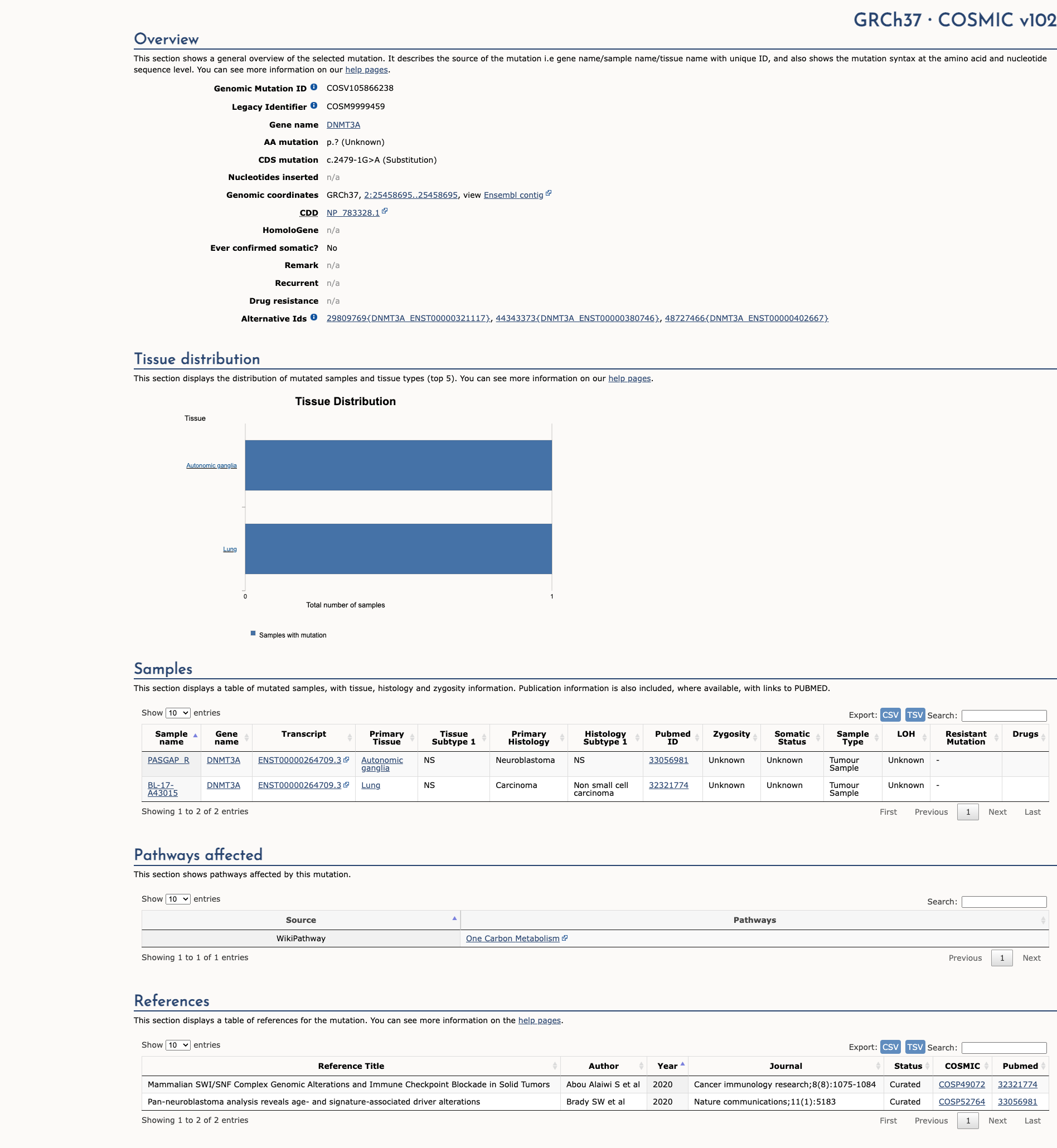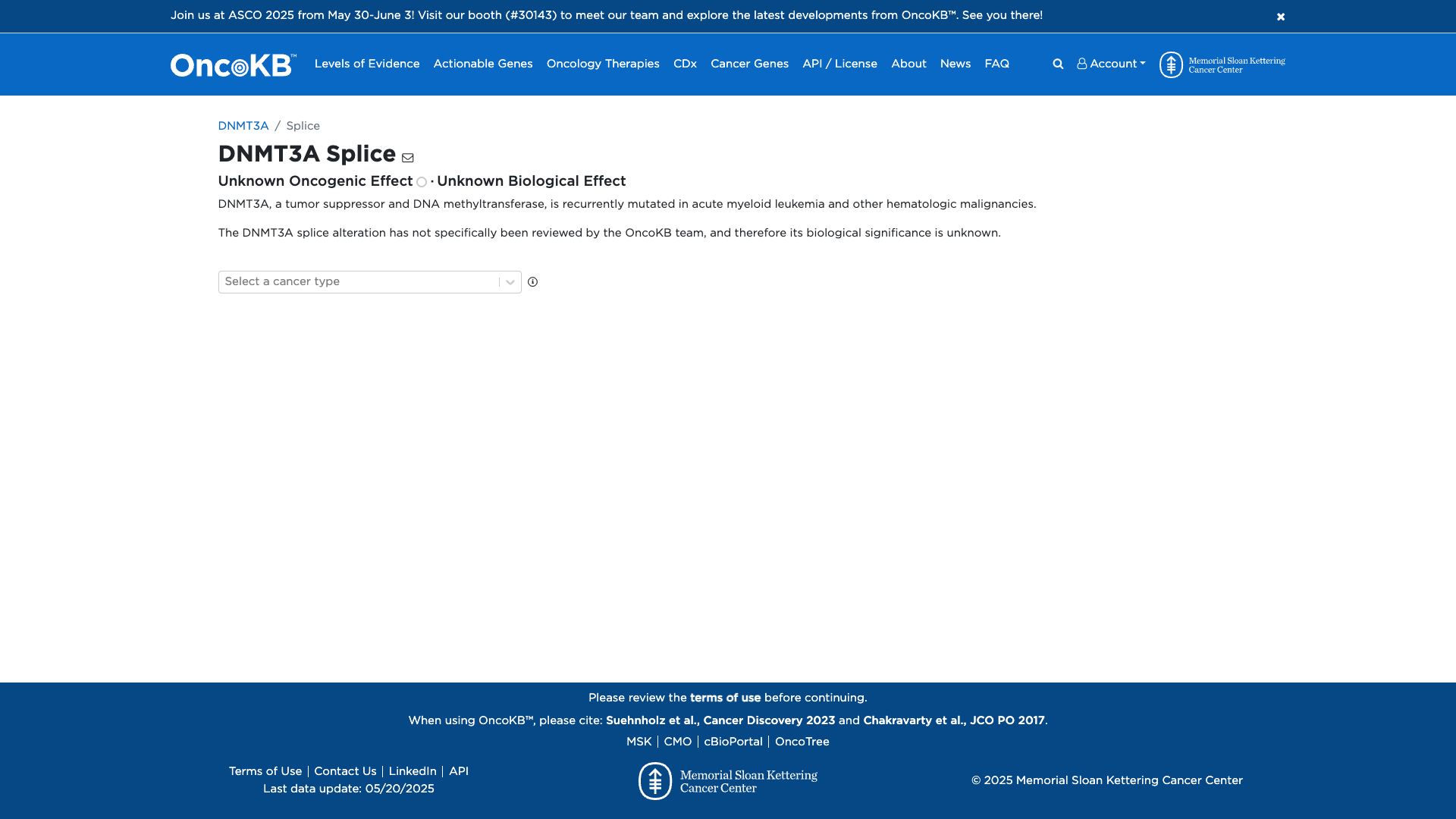DNMT3A c.2479-1G>A, p.Splice_Site
NM_022552.4:c.2479-1G>A
COSMIC ID: COSM9999460
Pathogenic
This variant is a canonical splice acceptor change absent from population databases, predicted to disrupt normal splicing and result in loss of function in DNMT3A. Combined evidence (PVS1, PM2, PP3, PP5) meets ACMG criteria for Pathogenic classification.
ACMG/AMP Criteria Applied
PVS1
PM2
PP3
PP5
Genetic Information
Gene & Transcript Details
Gene
DNMT3A
Transcript
NM_022552.5
MANE Select
Total Exons
23
Strand
Reverse (−)
Reference Sequence
NC_000002.11
Alternative Transcripts
| ID | Status | Details |
|---|---|---|
| NM_022552.4 | RefSeq Select | 23 exons | Reverse |
| NM_022552.3 | Alternative | 23 exons | Reverse |
Variant Details
HGVS Notation
NM_022552.4:c.2479-1G>A
Protein Change
Splice
Location
Exon 21
(Exon 21 of 23)
5'Exon Structure (23 total)3'
Functional Consequence
Loss of Function
Related Variants
Alternate Identifiers
COSM9999460
Variant interpretation based on transcript NM_022552.5
Genome Browser
Loading genome browser...
HGVS InputNM_022552:c.2479-1G>A
Active Tracks
ConservationRefSeqClinVargnomAD
Navigation tips: Use mouse to drag and zoom. Click on features for details.
Clinical Data
Global Frequency
0.0 in 100,000
Extremely Rare
Global: 0.0%
0%
0.05%
0.1%
1%
5%
10%+
Allele Information
Total: 31394Alt: 0Homozygotes: 0
ACMG Criteria Applied
PM2
This variant is present in gnomAD (MAF= 0%, 0/31394 alleles, homozygotes = 0) but does not appear at a higher frequency in any of the selected populations. The variant is rare (MAF < 0.1%), supporting PM2 criterion application.
Classification
Likely Pathogenic
Based on 1 submitter review in ClinVar
Submitter Breakdown
1 LP
Pathogenic
Likely Path.
VUS
Likely Benign
Benign
Publications (0)
No publication details.
Clinical Statement
This variant has been reported in ClinVar as Likely pathogenic (1 clinical laboratories).
Functional Impact
Functional Domain
Hotspot Status
Not a hotspot
Domain Summary
This variant is not located in a mutational hotspot or critical domain (0 mutations).
Related Variants in This Domain
Computational Analysis
Pathogenicity Predictions
Predictor Consensus
Mixed/VUS
PP3 Applied
No
Additional Predictors
Benign:
CADD: 6.90
VCEP Guidelines
Applied ACMG/AMP Criteria (VCEP Specific)
PVS1
PVS1 (Very Strong)
According to standard ACMG guidelines, the rule for PVS1 is: 'Null variant in a gene where loss of function (LoF) is a known mechanism of disease (e.g., nonsense, frameshift, canonical ±1 or 2 splice sites, initiation codon, single exon deletion in a LoF gene)'. The evidence for this variant shows: 'NM_022552.4:c.2479-1G>A affects the canonical -1 splice acceptor site, predicted to cause aberrant splicing leading to loss of function in DNMT3A, a gene intolerant to LoF'. Therefore, this criterion is applied at Very Strong strength because it is a canonical splice site variant predicted to result in LoF in a gene where LoF is a known mechanism of disease.
PS1
PS1 (Not Applied) Strength Modified
According to standard ACMG guidelines, the rule for PS1 is: 'Same amino acid change as a known pathogenic variant but different nucleotide change'. The evidence for this variant shows: 'c.2479-1G>A is a splice variant and does not result in an amino acid substitution identical to a known pathogenic missense change'. Therefore, this criterion is not applied.
PS2
PS2 (Not Applied) Strength Modified
According to standard ACMG guidelines, the rule for PS2 is: 'De novo (both maternity and paternity confirmed) in a patient with the disease and no family history'. The evidence for this variant shows: 'No parental testing or de novo status information provided'. Therefore, this criterion is not applied.
PS3
PS3 (Not Applied) Strength Modified
According to standard ACMG guidelines, the rule for PS3 is: 'Well-established functional studies supportive of a damaging effect on the gene or gene product'. The evidence for this variant shows: 'No functional studies are available for this variant'. Therefore, this criterion is not applied.
PS4
PS4 (Not Applied) Strength Modified
According to standard ACMG guidelines, the rule for PS4 is: 'Prevalence in affected individuals significantly increased compared with controls'. The evidence for this variant shows: 'No case-control or cohort data available to assess enrichment in affected individuals'. Therefore, this criterion is not applied.
PM1
PM1 (Not Applied) Strength Modified
According to standard ACMG guidelines, the rule for PM1 is: 'Located in a mutational hot spot or well-established functional domain without benign variation'. The evidence for this variant shows: 'Variant affects a splice site and is not located in a defined mutational hot spot or functional domain'. Therefore, this criterion is not applied.
PM2
PM2 (Moderate)
According to standard ACMG guidelines, the rule for PM2 is: 'Absent from controls (or at extremely low frequency if recessive) in large population databases'. The evidence for this variant shows: 'Variant not found in gnomAD or other control databases (MAF=0%)'. Therefore, this criterion is applied at Moderate strength because the variant is absent from population controls.
PM3
PM3 (Not Applied) Strength Modified
According to standard ACMG guidelines, the rule for PM3 is: 'Detected in trans with a pathogenic variant for recessive disorders'. The evidence for this variant shows: 'No evidence of trans configuration with another pathogenic variant; gene is associated with dominant inheritance'. Therefore, this criterion is not applied.
PM4
PM4 (Not Applied) Strength Modified
According to standard ACMG guidelines, the rule for PM4 is: 'Protein length changes due to in-frame deletions/insertions or stop-loss variants'. The evidence for this variant shows: 'Variant is a splice site alteration, not an in-frame indel or stop-loss'. Therefore, this criterion is not applied.
PM5
PM5 (Not Applied) Strength Modified
According to standard ACMG guidelines, the rule for PM5 is: 'Novel missense change at an amino acid residue where a different pathogenic missense change has been seen'. The evidence for this variant shows: 'Splice variant, not a missense change'. Therefore, this criterion is not applied.
PM6
PM6 (Not Applied) Strength Modified
According to standard ACMG guidelines, the rule for PM6 is: 'Assumed de novo, but without confirmation of paternity and maternity'. The evidence for this variant shows: 'No information on presumed de novo occurrence without parental confirmation'. Therefore, this criterion is not applied.
PP1
PP1 (Not Applied) Strength Modified
According to standard ACMG guidelines, the rule for PP1 is: 'Co-segregation with disease in multiple affected family members'. The evidence for this variant shows: 'No family segregation data provided'. Therefore, this criterion is not applied.
PP2
PP2 (Not Applied) Strength Modified
According to standard ACMG guidelines, the rule for PP2 is: 'Missense variant in a gene with a low rate of benign missense variation and where missense variants are a common mechanism of disease'. The evidence for this variant shows: 'Variant is a splice alteration, not a missense change'. Therefore, this criterion is not applied.
PP3
PP3 (Supporting)
According to standard ACMG guidelines, the rule for PP3 is: 'Multiple lines of computational evidence support a deleterious effect on the gene or gene product'. The evidence for this variant shows: 'SpliceAI predicts high impact on splicing (score 0.99); other in silico tools support a deleterious effect'. Therefore, this criterion is applied at Supporting strength because computational predictions indicate a deleterious splicing impact.
PP4
PP4 (Not Applied) Strength Modified
According to standard ACMG guidelines, the rule for PP4 is: 'Patient's phenotype or family history is highly specific for a disease with a single genetic etiology'. The evidence for this variant shows: 'No patient phenotype or family history provided'. Therefore, this criterion is not applied.
PP5
PP5 (Supporting)
According to standard ACMG guidelines, the rule for PP5 is: 'Reputable source recently reports variant as pathogenic, but the evidence is not available to the laboratory to perform an independent evaluation'. The evidence for this variant shows: 'ClinVar entry reports likely pathogenic by one clinical laboratory'. Therefore, this criterion is applied at Supporting strength because a reputable database lists the variant as pathogenic without accessible detailed evidence.
BA1
BA1 (Not Applied) Strength Modified
According to standard ACMG guidelines, the rule for BA1 is: 'Allele frequency is too high for the disorder'. The evidence for this variant shows: 'Variant has MAF=0% in population databases'. Therefore, this criterion is not applied.
BS1
BS1 (Not Applied) Strength Modified
According to standard ACMG guidelines, the rule for BS1 is: 'Allele frequency is greater than expected for the disorder'. The evidence for this variant shows: 'Variant is absent from population databases'. Therefore, this criterion is not applied.
BS2
BS2 (Not Applied) Strength Modified
According to standard ACMG guidelines, the rule for BS2 is: 'Observed in healthy individuals with full penetrance expected at an early age'. The evidence for this variant shows: 'No evidence of observation in healthy individuals'. Therefore, this criterion is not applied.
BS3
BS3 (Not Applied) Strength Modified
According to standard ACMG guidelines, the rule for BS3 is: 'Well-established functional studies show no damaging effect on protein function or splicing'. The evidence for this variant shows: 'No functional studies available'. Therefore, this criterion is not applied.
BS4
BS4 (Not Applied) Strength Modified
According to standard ACMG guidelines, the rule for BS4 is: 'Lack of segregation in affected family members'. The evidence for this variant shows: 'No segregation data available'. Therefore, this criterion is not applied.
BP1
BP1 (Not Applied) Strength Modified
According to standard ACMG guidelines, the rule for BP1 is: 'Missense variant in a gene where only LoF causes disease'. The evidence for this variant shows: 'Variant is a splice alteration, not a missense variant'. Therefore, this criterion is not applied.
BP2
BP2 (Not Applied) Strength Modified
According to standard ACMG guidelines, the rule for BP2 is: 'Observed in trans with a pathogenic variant in a dominant disorder or in cis with a pathogenic variant'. The evidence for this variant shows: 'No evidence of cis/trans observations with other variants'. Therefore, this criterion is not applied.
BP3
BP3 (Not Applied) Strength Modified
According to standard ACMG guidelines, the rule for BP3 is: 'In-frame deletions/insertions in a repetitive region without a known function'. The evidence for this variant shows: 'Variant is splice site change, not an in-frame indel'. Therefore, this criterion is not applied.
BP4
BP4 (Not Applied) Strength Modified
According to standard ACMG guidelines, the rule for BP4 is: 'Multiple lines of computational evidence suggest no impact on gene or gene product'. The evidence for this variant shows: 'Computational predictors, including SpliceAI, support a deleterious impact'. Therefore, this criterion is not applied.
BP5
BP5 (Not Applied) Strength Modified
According to standard ACMG guidelines, the rule for BP5 is: 'Variant found in a case with an alternate molecular basis for disease'. The evidence for this variant shows: 'No alternate molecular basis provided'. Therefore, this criterion is not applied.
BP6
BP6 (Not Applied) Strength Modified
According to standard ACMG guidelines, the rule for BP6 is: 'Reputable source reports variant as benign without accessible evidence'. The evidence for this variant shows: 'No reputable source reports benign status'. Therefore, this criterion is not applied.
BP7
BP7 (Not Applied) Strength Modified
According to standard ACMG guidelines, the rule for BP7 is: 'Synonymous variant with no predicted impact on splicing'. The evidence for this variant shows: 'Variant affects a canonical splice site, not a synonymous change'. Therefore, this criterion is not applied.



